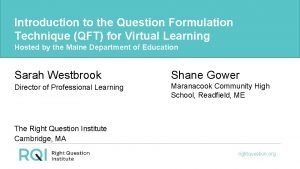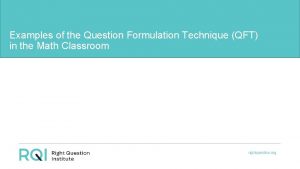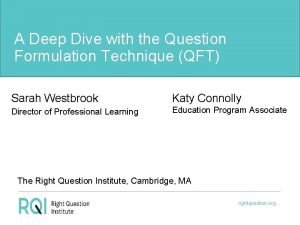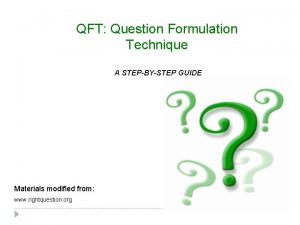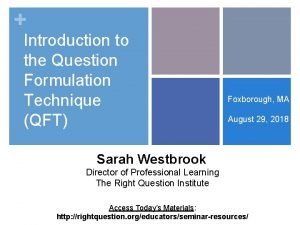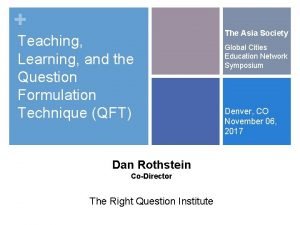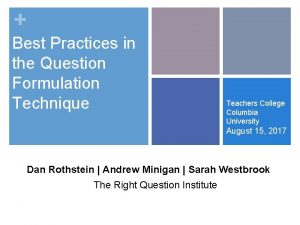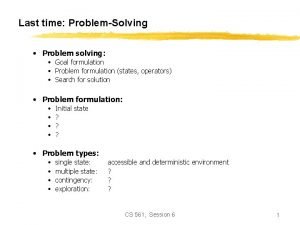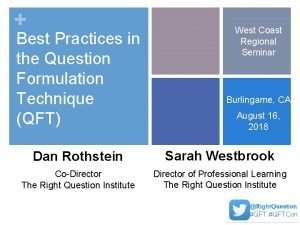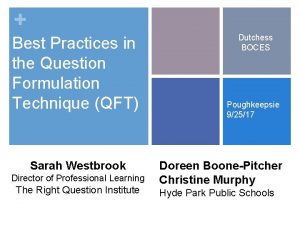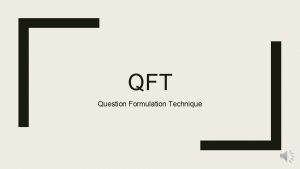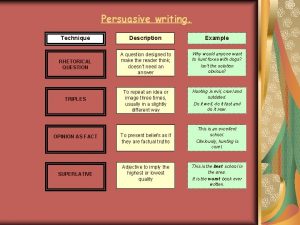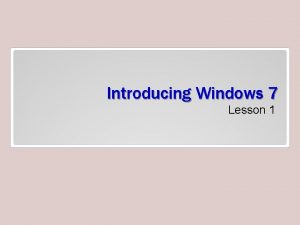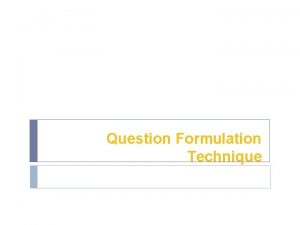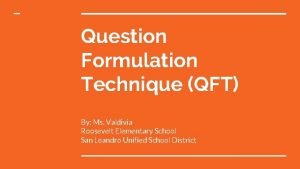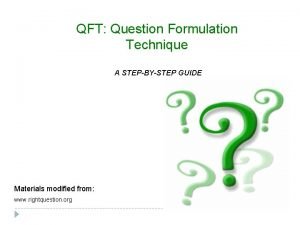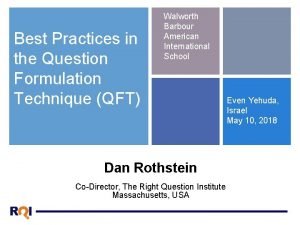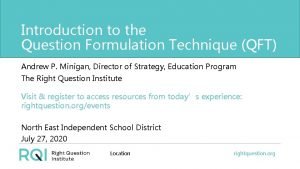INTRODUCING THE QUESTION FORMULATION TECHNIQUE QFT AP Seminar




















- Slides: 20

INTRODUCING THE QUESTION FORMULATION TECHNIQUE™ (QFT™) AP Seminar Quarter 2 2018

WHAT IS THE QUESTION FORMULATION TECHNIQUE™? The Question Formulation Technique (QFT) is a simple step-by-step process designed to help students produce, improve and strategize on how to use their questions. The QFT allows students to practice three thinking abilities in one process: divergent, convergent and metacognitive thinking.

COMPONENTS OF THE QUESTION FORMULATION TECHNIQUE™ 1. The Question Focus (QFocus) 2. Producing Questions following 4 Rules 3. Categorizing Questions 4. Prioritizing Questions 5. Next Steps 6. Reflection

RULES FOR PRODUCING QUESTIONS § Ask as many questions as you can § Do not stop to answer, judge or to discuss the questions § Write down every question exactly as it is stated § Change any statement into a question

PRODUCING QUESTIONS Groups of 2 -3 Identify the note-taker or scribe Focus on visual Frida Kahlo "Self-Portrait Between the Borderline of Mexico and the United States"

ACTIVITY: Produce as many questions as you can in allotted time Follow the rules for producing questions Number the questions


Categorizing Questions

Closed vs. Open-ended Questions Closed-ended Questions can be answered with a “yes’ or “no” or with a one-word answer. Open-ended Questions require more explanation.

Categorize Your Questions mark the questions that are closed-ended with a “C” mark the questions that are open-ended with an “O”

Comparing What are the advantages and disadvantages of open-ended questions? What are the advantages and disadvantages of close-ended questions?

Practice changing questions: Choose one closed-ended question from your list and change it into an openended one. Choose one open-ended question from your list and change it into an closedended one.

Prioritizing Questions

Prioritizing Questions Choose three questions… • that most interest you.

Choose three questions… • that are most important.

Choose three questions… • that will best help you design a research project.

Choose three questions… • you want/need to answer first.

Rationale Why did you choose these three?

SHARE and COLLABORATION 1. The questions changed from closed to open-ended and then from open-ended to closed-ended Read the original question Read the new question 2. 3 priority questions 3. Reasons for choosing the priority questions. Assign a group member to report or collaborate in reporting.

Reflections Think about the work you have done, what have you learned and its value. For example: What did you learn? What is the value of learning to ask your own questions? How can you use what you learned?
 Qft technique
Qft technique Question focus technique
Question focus technique Qft examples
Qft examples Question formulation technique worksheet
Question formulation technique worksheet Question formulation technique worksheet
Question formulation technique worksheet Question formulation technique pdf
Question formulation technique pdf Question formulation technique
Question formulation technique Question formulation technique worksheet
Question formulation technique worksheet Qft questioning
Qft questioning Why problem formulation follow goal formulation
Why problem formulation follow goal formulation Qft questioning
Qft questioning Instantons
Instantons Qft protocol
Qft protocol What is qft
What is qft Costa's level questions
Costa's level questions What is a world connection question
What is a world connection question Example of rhetorical question
Example of rhetorical question Introducing broker vs carrying broker
Introducing broker vs carrying broker Define upgrade advisor
Define upgrade advisor Talk boost tracker
Talk boost tracker Introducing illustrator 2013 download
Introducing illustrator 2013 download

